| |
|
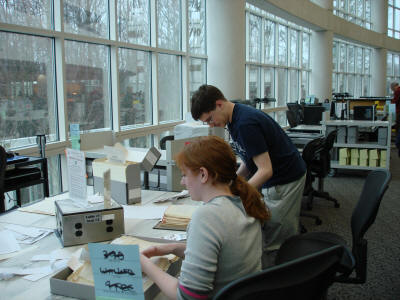 Page
8
of Fat File on Sandino Situation,
US Military Intelligence Division, 1928-33 Page
8
of Fat File on Sandino Situation,
US Military Intelligence Division, 1928-33
Documents are presented
here in their original sequence as found in three bulging file folders
titled "Sandino Situation,"
Record Group 165, Entry 77, Box
2653, US National Archives II,
College Park MD.
(Photo: Lebanon Valley
College student researchers
Missy Zellner & Nick Quadrini,
National Archives II, Jan 2010)
Grateful appreciation is extended to Mr. Brandon Ray,
Summa Cum Laude college graduate from
Ashford University in Iowa (with a B.A. in
History and a minor in Political Science) for
his exacting transcriptions on this page and the
previous seven pages. Thank you Brandon!
|
|
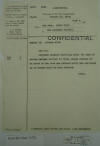
|
1.
October 27, 1930.
Confidential G-2 Report on
Sócrates Sandino, Major Fred T. Cruse, Military
Attaché, San José, to the
Adjutant General, War
Department.
"CONFIDENTIAL. Number 12.
October 27th. For G-2.
Socrates Sandino traveling under
the name of Santos Salazar
arrived in Punta Arenas October
25 en route to San Jose was
refused entry and continued on
to Panama which we have
advised."
|
|
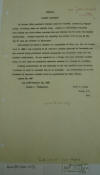
|
2. October 23, 1930.
G-2 Report on Sandino Situation,
Major Fred T. Cruse, Military
Attaché, San José.
"On
October 20th Sandino's brother
Socrates Sandino, arrived in
Tegucigalpa, traveling under an
assumed name. Acting on
information received from Mexico
the authorities arrested him and
ordered him to leave the Country
immediately. Sandino
admitted his identity and stated
that he was on the way to join
his brother in Nicaragua.
Authorities in Central America
are suspicious of this man, for
the reason that in 1928 a man
claiming to be Socrates Sandino
appeared in Guatemala and for
several weeks published radical
propaganda and collected funds
for the Sandino revolution.
He was expelled as a fraud, the
real Socrates Sandino being at
that time an automobile mechanic
working in a Garage in Brooklyn.
Pending confirmation of the
identity of the man expelled
from Honduras, I believe it wise
to consider him an imposter.
Any information as to the
location of Socrates Sandino
would be appreciated by this
office."
|
|
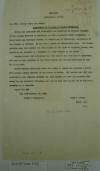
|
3.
October 17, 1930.
G-2 Report on Indications of
Collapse of Bandit Activities, Major Fred T. Cruse, Military
Attaché, San José.
"During the last month
all information has indicated an
imminent collapse of the Sandino
Movement in Nicaragua, as well
as general bandit activities.
A short while ago Feliciano
Centeno, an adopted son of
Altamirano, surrendered to the
Guardia in Jinotega. He
had been a member of
Altamirano's band. He
brought definite news that
Sandino had been wounded in the
fight at Saguasca [Saraguasca],
having been struck in the
shoulder by a fragment of a bomb
dropped by the plane.
Centeno states that Altamirano
has been anxious for some time
to surrender, and that he only
continues in the field because
his men had threatened to him
him if he quit. Recent
Mexican newspapers state that
Pedro J. Zepeda has received a
letter from Sandino asking
approval of his return to
Mexico. All bandits who
have surrendered or been
captured recently say that
Sandino has lost all prestige
even among his own immediate
followers, and that he will have
to get out of Nicaragua promptly
or be captured."
[excellent example of poor &
spotty intelligence; on the
surrender of Feliciano Centeno
Altamirano, see
Top
100, Doc 56
]
|
|
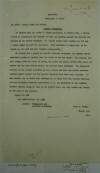
|
4. October 17, 1930.
G-2 Report on Bandit Activities,
Major Fred T. Cruse, Military
Attaché, San José.
"On
October 5th, Pedro J. Zepeda
published, in Mexico City, a
strong attack on Sandino for his
failure to make any showing
against the Marines and Guardia
in his second campaign.
Dr. Zepeda states that Sandino
has not won a single fight
against his opponents.
This criticism is important, as
Dr. Zepeda is the last and only
Sandino propagandist. On
October 2nd a patrol of Guardia
Nacional commanded by Captain
Hunter ambushed a group of
bandits near the mouth of the
Cua River. The bandits,
who were coming down the river
in boats, had seven men killed
before they could get ashore and
two more killed during the
pursuit which followed.
The important feature of the
bandit situation is that during
the last six months contacts
between bandit groups and the
Guardia Nacional have been very
frequent. As the bandits
try to avoid such meetings it is
clear that the Guardia Nacional
are now obtaining accurate
information as to the movements
of the bandits. Another
notable thing is that in the
fights there are very seldom any
losses on the part of the
Guardia. ... Source - Newspapers
and personal knowledge."
|
|
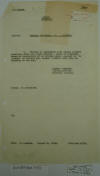
|
5.
October 10, 1930. G-2
Translation of "Sandino
Will Keep On Fighting To the
End,"
La Prensa,
Oct. 8, 1930,
Col. Gordon Johnston,
Military Attaché, Mexico City, p. 1.
"G-2
Report ¶ 3850: ¶ MEXICO ¶
POLITICAL ¶ SUBJECT: Foreign
Relations – C. A. SANDINO. ¶ 1.
Further in connection with
recent reports submitted under
the above subject.- there is
forwarded herewith translation
of an article which appeared in
“La Prensa” of October 8th,
headed “Sandino will keep on
Fighting to the end.” ¶ Gordon
Johnston, ¶ Colonel, Cavalry, ¶
Military Attaché. ¶ Source: As
indicated. ¶ J/p ¶ From:
M.A.Mexico. ¶ Report No. 3108. ¶
Date: Oct. 10/30."
|
|
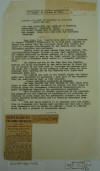
|
6.
October 10, 1930. G-2
Translation of "Sandino
Will Keep On Fighting To the
End,"
La Prensa,
Oct. 8, 1930, Col. Gordon
Johnston, Military Attaché,
Mexico City, p. 2.
"Translation
of article appearing in “La
Prensa” of October 8, 1930. ¶
SANDINO WILL KEEP ON
FIGHTING IN NICARAGUA UNTIL THE
END. ¶ With arms taken from the
enemy he is fighting
persistently. Formidable chaos.
¶ The United States will be
unable to control the anarchy
which will come with the
electoral campaign. ¶
Vera Cruz, V.C. Reports have
just arrived, addressed to
General Sandino’s representative
in this port, denying as absurd
the rumors that the insurgent
chief will abandon the fight in
Nicaragua disillusioned by the
defeats which the Nicaraguan
patriots have suffered. ¶
Nothing could be more absurd
than such reports, for,
notwithstanding General Sandino
is only just recovering from his
wounds sustained in recent
combats, he is still possessed
of sufficient vigor to keep up
the fight against the invaders.
He says that to withdraw would
amount to a shameful
capitulation. ¶ The rumors are
due to the fact that the
American marines are being
reinforced by new units, trying
to drown the cry of protest by
the true sons of Nicaragua who,
however, will not cease for a
moment in the struggle against
those who have profaned their
country, but on the contrary
will fight more intensely every
day. ¶ The reports say that in
the recent fights the insurgents
have succeeded in capturing a
good part of the armament from
the Americans, as well as food
supplies. ¶ Strong political
agitation in Managua. ¶ The same
reports say that Sandino is well
aware that there is much
political agitation in Managua
and that there is division among
the government authorities
themselves, due to grave
differences regarding the
presidential candidate. ¶ This
situation is further aggravated
by the approaching campaign for
the election of senators, as the
situation is reaching an acute
stage and the government
elements are themselves creating
difficulties and are becoming
estranged from each other. ¶
With all these details it is
expected that the situation in
Nicaragua will become more
serious and that the Americans
themselves will be unable to
control a state of affairs which
is only a prelude to formidable
chaos. ¶ AGENTS ON
LOOK-OUT FOR ARMS SHIPMENT
¶ Customs Bureau
Informed Nicaraguan Insurgents
May Be Receiving U. S. Supplies.
¶ The Customs Bureau, acting on
information that Nicaraguan
insurgents may be obtaining
rifles and ammunition form the
United States by way of
Honduras, has instructed its
collectors to take special
precautions against such
exportation. ¶ Commissioner of
Customs Eble informed the
collectors he had been told by
the State Department that
applications had been received
for the shipment of
“considerable amounts of small
caliber rifles and cartridges to
certain firms in Honduras
suspected of trafficking with
Nicaraguan bandits.” ¶ “The
bureau is advised there appears
to be reason for believing the
rifles and cartridges may
actually be of larger caliber
than is specified in the
application,” he added. Eble
instructed the collectors to
take special precautions “to
ascertain that all shipments of
arms and ammunition to Honduras
are actually as represented in
the permit.” . . . "
|
|
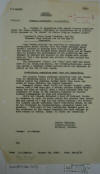
|
7. October 4, 1930.
G-2 Translation of "Sandino's Cause Grows Stronger
& Two Thousand More Marines are
on the way to Nicaragua,"
La Prensa,
Oct. 2, 1930, Colonel Gordon
Johnston, Military Attaché,
Mexico City.
"... The Sandino forces continue
receiving arms and ammunition in
abundance, which it is believed
are sent from Belize across the
Honduran border until they reach
the hands of those fighting the
Yankee invaders. Generals
Miguel Angel Ortíz and Carlos
Salgado, after having left, a
few days ago, a strong Sandino
column threatening the town of
Estelí, made a rapid movement
from the proximity of Limay to
the Honduran boundary, to
receive another consignment of
arms and cartridges. Ortíz
and Salgado defeated a band of
National Guards in Quebrada de
Agua, in which action the
planter Cruz Osorio who had
served as a spy for the Yankee
marines, was killed. The
Sandino chiefs continued their
victorious march, by way of San
Francisco de Guajiniquilapa,
occupying towns and ranches.
This raid of the Sandinistas
brought panic to the partisans
of the Yankee invasion, who were
obliged to seek refuge in
Estelí, Limay, El Sauce and
Somotillo."
|
|
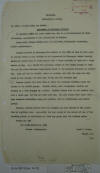
|
8. October 2, 1930.
G-2 Report on Surrender of
Feliciano Centeno, Major Fred T.
Cruse, Military Attaché, San
José.
"NICARAGUA ¶ POPULATION & SOCIAL
¶ No. 2700 – Public Order and
Safety. ¶ Surrender of Feliciano
Centeno. ¶ On September 27th the
above named man, who is a
brother-in-law of Pedro
Altamirano, surrendered to the
authorities in Managua. ¶ Among
other things Centeno gave the
following information concerning
bandit activities:-- ¶ Sandino
arrived in Nicaragua from Mexico
on the 15th of June of this
year. In letters which he had
written to his supporters in
Nicaragua before leaving Mexico
he stated that he would arrive
with a large quantity of arms
and a large number of men. As a
result the principal chiefs of
the bandit groups in Segovia and
the other Northern Departments
moved to the Honduran Frontier
to receive him. They met him in
Quilali, where he arrived, not
with the arms and army which he
had stated, but with only 15 men
and one Thompson gun. ¶ Centeno
states that from then on there
was constant friction among the
chiefs of the bandit groups.
Shortly after, near Saraguasca,
Sandino was wounded by a bomb
dropped by a plane. Centeno
states that he saw Sandino less
than a month ago, but did not
talk with him. He also states
that there have been numerous
desertions among the bandits,
both by individuals and entire
groups. ¶ Finally, Centeno
states that the bandits are more
afraid of the planes than of
anything else. Apparently the
mere sound of the motors of one
of the scouting planes is
sufficient to throw any group
into the wildest panic. ¶ Report
No. 909 ¶ San José--October 2,
1930 ¶ Source – Newspapers. ¶
Fred T. Cruse, ¶ Major, G.S. ¶
M.A." [NOTE: see
also Top
100, Doc 56
]
|
|
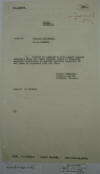
|
9. September 24, 1930.
G-2 Translations of Mexico City newspaper
articles on Sandino, Col. Gordon Johnston,
Military Attaché, Mexico City,
p. 1.
"G-2 Report ¶ 3850: ¶ MEXICO ¶
POLITICAL ¶ SUBJECT: Foreign
Relations: ¶ C. A. SANDINO ¶ 1.
Further in connection with
recent reports submitted under
the above subject, there is
forwarded herewith translation
of several articles appearing in
the press of September 15th and
21st. ¶ Gordon Johnston, ¶
Colonel, Cavalry ¶ Military
Attaché. ¶ Source: As stated. ¶
J/p ¶ From: M.A.Mexico. ¶ Report
No. 3081. ¶ Date: Sept. 24,
1930. . . . "
|
|
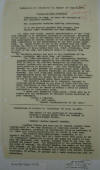
|
10. September 24, 1930.
G-2 Translations of Mexico City newspaper
articles on Sandino, Col. Gordon Johnston,
Military Attaché, Mexico City,
p. 2.
"
. . . Translation of article in
“La Prensa” of Sept. 15, 1930. ¶
“APPEAL TO FOUR
REPUBLICS” ¶ Cooperation is
asked, to cease the struggle in
the Argentine Republic. ¶ The
Sandinistas continue fighting
audaciously. ¶ It is not true,
as reported from Managua, that
General Pedro Altamirano has
been defeated. ¶ Dr.
Pedro José Zepeda, general
representative of the “Ejercito
Defensor de la Soberania
Nacional de Nicaragua”,
delivered to the press a copy of
the message which he has sent
out to the four governments of
Central America on the occasion
of September 15th, anniversary
of the independence of the five
sister republics. Dr. Zepeda
stated to one of our editors
that the fight against the
forces of Admiral Campbell was
being carried on with all
violence, it being untrue that
Gen. Pedro Altamirano, Chief of
Staff of the Army, had suffered
defeat as reported from Managua.
¶ The following message was sent
to the Presidents of San
Salvador, Guatemala, Costa Rica,
and Honduras: ¶ “The 109th
anniversary of our independence
inspires profound meditation
respecting the attitude of your
Government in face of the
military occupation of
Nicaragua. General Sandino, with
his men, continue challenging
the invader, heedless of
sacrifices. Has Your Excellency
given thought to a plan whereby
the struggle, which alike
affects the five Central
American republics, can
decorously be terminated? Has
Your Excellency reflected upon
the historic responsibility
which the vacillating attitude
of your Government imposes upon
the people who with their votes
consecrated you to patriotically
guide their destinies? ¶ “The
Ejercito Defensor de la
Soberania Nacional de Nicaragua,
which marches in the face of
death with the profound
conviction of duty fulfilled,
demands the attention of Your
Excellency to assist in ending a
state of affairs prejudicial to
Continental honor. ¶ “I await
your immediate reply which I
trust will be in accord with the
principles of national ethics
sustained by your Government. ¶
“Patria y Libertad, ¶ Dr. José
Zepeda, ¶ General Representative
of the Army.” ¶ Translation of
article in “Excelsior” of Sept.
21, 1930. ¶ “New defeat of the
Americans at Saraguazco. ¶
“Sandino’s troops killed five
and wounded 14 in a hard-fought
battle. ¶ “General Sandino
himself wounded. ¶ “Another
victory has been won by General
Augusto Cesar Sandino, chief of
the army fighting in Nicaragua
against the American invaders,
according to information given
us yesterday by Dr. Pedro José
Zepeda, representative in Mexico
of that army. ¶ “The reports
from headquarters –according to
Dr. Zepeda’s bulletin- state
that in a fight which took place
in the “El Saraguazco” sector,
and in which the enemy was
unable to capture our positions,
Gen. Sandino, Supreme Chief of
our army, was wounded the second
time. The indignation of the
soldiers reached the pitch of
madness, and without heeding the
number of the enemy, they
charged, and the invaders fled
in complete disorder, leaving on
the field of battle 14 wounded
and 5 dead; also several
thousand cartridges, 35 rifles,
19 pistols and a Lewis
machine-gun with its ammunition.
. . . "
|
|
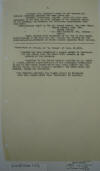
|
11.
September 24, 1930.
G-2 Translations of Mexico City newspaper
articles on Sandino, Col. Gordon Johnston,
Military Attaché, Mexico City,
p. 3.
"
. . . Although Gen. Sandino’s
wound is not serious, all
medical attention possible has
been given him. ¶ Generals
Altamirano, Estrada, Ortiz and
Irias have continued at the head
of their columns in the Northern
sector of the country, and
besides, the following
appointments have been made: ¶
Expeditionary chief in the Rio
Grande sector, Gen. Adán Gómez;
¶ “ “ “ “ Puerto Cabezas zone,
Gen. Adolfo Covans; ¶ “ “ “ “
Rio Coco district, Col. Abraham
Rivera. ¶ These columns were
organized on the 9th of this
month, unfortunately on the same
day Gen. Sandino was wounded,
but who notwithstanding,
overlooks no detail toward
securing final success. ¶
Translation of article in “La
Prensa” of Sept. 21, 1930. ¶
“Sandino has been wounded, in a
recent combat in Nicaragua. ¶
“For the second time the chief
falls wounded by the bullets of
the invaders. ¶ According to the
latest reports received by Dr.
Pedro J. Zepeda, general
representative of the Nicaraguan
insurgents, in one of the recent
fights which took place between
the Sandinista troops and the
American invaders, the rebel
chief was wounded, though not
seriously. ¶ (The bulletin
covering the Zepeda report is
identical with that copied above
from “Excelsior” of Sept. 21.)."
|
|
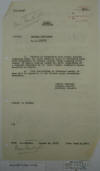
|
12.
September 12, 1930. G-2
Translation of "48
COMBATS IN ONLY FIFTEEN DAYS—An
Official Bulletin of the Latest
Activities of the Nicaraguan
Revolutionaries Against the Army
of Occupation,"
La Prensa,
Aug. 30, 1930, Col. Gordon
Johnston, Military Attaché,
Mexico City, p. 1.
"G-2 Report ¶ 3850: ¶ MEXICO ¶
POLITICAL ¶ SUBJECT: Foreign
Relations: ¶ C. A. SANDINO ¶ 1.
Further in connection with
recent reports submitted under
the above subject, there is
forwarded herewith translation
of another article which
appeared in “La Prensa” of
Mexico City, on August 30, 1930,
consisting of a bulletin
furnished by Dr. Pedro Zepeda,
Sandino’s representative in
Mexico. ¶ 2. This translation is
forwarded merely to show what is
appearing in the Mexican press
concerning Nicaragua. ¶ Gordon
Johnston ¶ Colonel, Cavalry ¶
Military Attaché. ¶ Source: As
stated. ¶ J/p ¶ From:
M.A.Mexico. ¶ Report No. 3077. ¶
Date: Sept. 12, 1930. . . . "
|
|
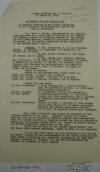
|
13. September 12, 1930.
G-2 Translation of "48 COMBATS IN ONLY FIFTEEN
DAYS—An Official Bulletin of the
Latest Activities of the
Nicaraguan Revolutionaries
Against the Army of Occupation,"
La Prensa,
Aug. 30, 1930, Col. Gordon
Johnston, Military Attaché,
Mexico City, p. 2.
" . . . Article published in “LA
PRENSA” of August 30, 1930. ¶
48 COMBATS IN ONLY
FIFTEEN DAYS ¶ An official
bulletin of the latest
activities of the Nicaraguan
revolutionaries against the Army
of Occupation. ¶ Dr.
Pedro J. Zepeda, representative
of Sandino’s Army delivered to
us last night a bulletin of the
combats in different regions of
Nicaragua between the
Nicaraguans and the Yankee
marines, showing 32 insurgents
killed and 23 wounded, in the
various encounters in the first
half of the present month
(August). ¶ Combats: By Gen.
Altamirano, 6, in the following
places: El Malacate, El
Quebradón, Los Cedros, (2), La
Colonia and El Huate. ¶ By Gen.
Carlos Salgado, 3: Rio Negro,
Los Robles, and El Limón. ¶ By
Gen. Miguel Angel Orthéz y
Guillen, 15, as follows: At El
Cerco de Piedra, Quebrada, El
Guineo, El Bramadero, Rio Negro,
La Cabulla, Los Limones, Arado
Quemado, San Francisco de
Coajiniquilapa, Los Robles de
Someto Grande, La Rica, Yali, El
Balsamo, El Cajón, El Limón, and
El Ojoche. ¶ Total, 24 combats.
¶ Losses in the expeditionary
forces under Gen. Pedro
Altamirano: 8 killed and 1
wounded. ¶ Under Gen. Carlos
Salgado: 9 killed and [5 or 6]
wounded. ¶ Under Gen. Orthéz y
Guillen, 15 killed and 17
wounded. ¶ Seized from the
enemy: ¶ By Gen. Altamirano: 1
Lewis machine-gun, 1 Brenis
machine-gun; 30 Springfield
rifles. All with their
corresponding ammunition. ¶ By.
Gen. Salgado: 11 Springfield
rifles, with ammunition. ¶ By
Gen. Orthéz: 2 Thompson
machine-guns; 15 Springfield
rifles; all with ammunition;
also a quantity of important
documents belonging to the
enemy. ¶ By Gen. Altamirano:
$500.00 in cash, a quantity of
gold amounting to over
$3,000.00; 100 mules completely
saddled; 260 pistols completely
equipped, and 10 cwt. of
dynamite powder, with equipment.
¶ Gen. Pedro Altamirano was
chosen as commander of this
Supreme Jefatura of our Army.
Generals Salgado and Orthéz
remained with their columns in
isolated regions with
instructions from the Supreme
Jefatura to maintain latent the
fire of patriotism before the
Nicaraguan people while Gen.
Sandino is abroad arranging
matters especially pertaining to
our Army. ¶ Signed and ratified
by the Supreme Chief (Sandino)
and the three other leaders
mentioned, August 20, 1930, at
Las Segovias. ¶ At the same time
there was also delivered to us
copy of Dr. Zepeda’s letter to
the correspondent of the United
Press, as that news agency is
carrying on a deceitful
campaign, in its news from
Managua, classing as “Bandits”
the men who are defending the
liberty and autonomy of their
country."
|
|
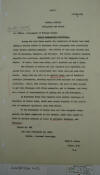
|
14. September 10,
1930. G-2 Report on Recent
Communistic Activities, Major Fred T. Cruse,
Military Attaché, San José.
"(COPY) ¶ (10058-129)
¶ 1 ¶ CENTRAL AMERICA ¶
POPULATION AND SOCIAL ¶ No.
2900-c – Propaganda of Foreign
Origin. ¶ Recent Communistic
Activities. ¶ During the last
three months the communists of
Mexico have been making a
serious effort to introduce
their propaganda into
practically every Central
American Republic. The effects
of this have already been felt
in Guatemala, Honduras, and
Salvador. The latter republic
recently expelled five
agitators, admittedly sent out
by the Communist Party of
Mexico. Of these, three were
Poles, one a Spaniard and one a
Cuban. ¶ The Governor of Belize
has just expelled five agitators
and jailed five more. It is
established that these also had
come from Mexico. Among them was
said to be Agustin Marti, one of
Sandino’s principal Lieutenants,
recently expelled from Salvador
for communistic activities.
Marti, with several followers,
was said to have planned to get
into Nicaragua with false
passports, get to Managua, and
carry out a series of
assassinations of leading men in
the Government. ¶ In Guatemala
there have recently been several
instances of disorders in Indian
towns, which were traced
directly to the activities of
communist agitators, also from
Mexico. ¶ If the Government of
Mexico does not take energetic
steps against the known
communists in the country, there
will sooner or later be serious
troubles at least in Salvador,
Honduras, and Nicaragua. ¶
Report No. 886 ¶ San
Jose--September 10, 1930. ¶
Source – Personal knowledge. ¶
Fred T. Cruse, ¶ Major, G.S. ¶
M.A."
|
|
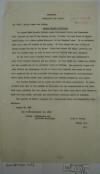
|
15.
September 10,
1930. G-2 Report on Recent
Bandit Activities, Major Fred T.
Cruse, Military Attaché, San
José.
"NICARAGUA
¶ POPULATION AND SOCIAL ¶ No.
2700 – Public Order and Safety.
¶ Recent Bandit Activities. ¶ On
August 20th Guardia Patrols
under Lieutenant Puller and
Lieutenant Lee, assisted by one
of the Corsair planes, attacked
the main force of Miguel Angel
Ortez, at a place called
Malacate, in the Guapinol area.
It is estimated that there were
80 bandits in the group. Of this
number two were killed by ground
troops and two by the plane.
Fifty two horses and mules,
probably all that the bandits
had, as well as four tons of
roasted corn were captured. ¶ On
the same date a Guardia Patrol
under Captain Good met
Altamirano’s main force between
Guapinol and Los Cedros. In this
fight one bandit was killed and
two wounded out of an estimated
total of fifteen. Two permanent
camps were also located and
destroyed, in one of them being
Pedron’s own house in which were
captured all of his personal
belongings and considerable
correspondence. There seems
little doubt that Altamirano was
himself wounded in this fight. ¶
The Guardia Patrols had no
losses in either of these
encounters. It seems evident
that most of the bandits in
Nicaragua are now concentrated
in the Guapinol area, probably
for the reason that there are
exits from there into Honduras,
down the Coco River, and into
the uninhabited mountains North
of Jinotega. ¶ The capture of
Ortez’ supplies will undoubtedly
force him temporarily into
Honduras. ¶ Report No. 885 ¶ San
José--September 10, 1930 ¶
Source – Newspapers and personal
knowledge. ¶ Fred T. Cruse, ¶
Major, G.S. ¶ M.A."
|
|
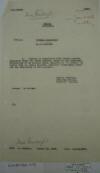
|
16. August 26, 1930.
G-2 Translation of "Nicaraguan Women and the
Bestiality of the Marines,"
La Prensa,,
Aug. 22, 1930, Col. Gordon
Johnston, Military Attaché,
Mexico City, p. 1.
"G-2 Report ¶ 3850: ¶ MEXICO ¶
POLITICAL ¶ SUBJECT: Foreign
Relations: ¶ C. A. SANDINO. ¶ 1.
Further in connection with
recent reports submitted under
the above subject, there is now
forwarded translation of an
article which appeared in “La
Prensa” of Mexico City on August
22, 1930, entitled “Nicaraguan
Women and the Bestiality of the
Marines”. ¶ Gordon Johnston, ¶
Colonel, Cavalry, ¶ Military
Attaché. ¶ Source: As stated. ¶
J/p ¶ From: M.A.Mexico. ¶ Report
No. 3059. ¶ Date: Aug. 26,
1930.- . . . "
|
|
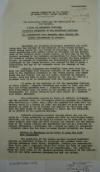
|
17.
August 26, 1930.
G-2 Translation of "Nicaraguan Women and the
Bestiality of the Marines," La Prensa,
Aug. 22, 1930, Col. Gordon
Johnston, Military Attaché,
Mexico City, p. 2.
" . . . (Translation) ¶ Article
appearing in “LA PRENSA” of
Mexico City, August 22, 1930. ¶
THE NICARAGUAN WOMEN,
AND THE BESTIALITY OF THE
MARINES. ¶ A Wave of Energetic
Protests. ¶ Prisoners subjected
to the cruellest [cruelest]
tortures. ¶ The Sandinistas have
recently been forcing the Yankee
detachments to retreat.
¶ Beautiful and virtuous
Nicaraguan señoritas are still
being made the victims of the
officers of the Yankee marines,
which occupy nearly all the
States of Nicaragua, and to the
outrages perpetrated with señora
Leonor de Brookman and the
kidnapping of the señorita Maria
Teresa Morice, we have now to
add the scandal produced by the
infamous persecutions to which
the beautiful señorita Dolores
Matamoros, of Nuevo Segovia
[Nueva Segovia] has been
subjected, who, on account of
rejecting the dishonorable
proposals of a lieutenant in the
Yankee marines, was accused by
him of being a sympathizer and
spy of the elements under the
command of Gen. Sandino. ¶
Señorita Matamoros was forcibly
taken away from her home and
threatened with terrible
tortures if she refused to
accede to the insulting
proposals of the Yankee marine
into whose hands she had fallen,
and she was taken, escorted by
National Guards, from her home
in Nuevo Segovia [Nueva
Segovia], to the city of León as
a prisoner said to be in
connivance with the Sandinistas.
¶ In spite of the protests of
all the honorable families of
Nuevo Segovia [Nueva Segovia],
Señorita Matamoros was taken to
León, and this vile act having
produced such a terrible
impression, appeals have been
coming from all parts of the
country to the Minister of
Gobernación, Dr. Julian Irías,
to have this insult to a
defenceless woman, punished. ¶
The reiterated appeals in favor
of señorita Matamoros and the
protests from all Nicaraguan
families, reached the
Gobernación Minister, Dr. Irias,
who, after the accused had been
kept for several weeks in a
prison in León, was obliged to
give her a safe conduct in order
to go to Managua and explain to
President Moncada the true cause
of the vengeance to which she
was subjected by an officer of
the American marines. ¶ Señorita
Matamoros reached Managua, where
she was received by a large
gathering of people who held an
anti-Yankee demonstration, and
she is now waiting in Managua to
be received by President Moncada
from whom she will shortly ask
justice and the punishment of
the Yankee officer who
persecutes her and has resorted
to conduct unbecoming a
gentleman and marine in order to
antagonize a helpless woman who
has done no wrong beyond
defending her honor. ¶ Justice
is beginning to be shown to many
who have been slandered. ¶ The
reprisals of the Yankee marines
against honorable persons in
different cities of Nicaragua
who aroused their ire through
defending their wives,
daughters, mothers, and
sweethearts from their lust,-
reprisals which have taken the
form of imprisonments in León,-
are beginning to be
investigated. The publicity
which has been given in all
Spanish-speaking countries to
the brutalities of the North
American invaders, has had its
effect. . . . "
|
|
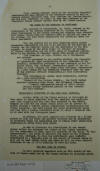
|
18.
August 26, 1930.
G-2 Translation of "Nicaraguan Women and the
Bestiality of the Marines," La Prensa,
Aug. 22, 1930, Col. Gordon
Johnston, Military Attaché,
Mexico City, p. 3.
"
. . . Capt. Johnson himself,
chief of the so-called electoral
commission, has been obliged to
ask President Moncada to call to
Managua Abraham Gutierrez Lobo,
Luis Paniagua and Abelino
Herrera, who had been “confined”
in León,- as they were innocent
of the stupendous crimes charged
against them by the Yankee
marines. ¶ The truth of the
Outrages is confirmed. ¶ The
Minister of Gobernación, Sr.
Irías, ordered an investigation
of the outrage committed by Lt.
Nichols and three other
lieutenants of the Yankee
Marines, who forcibly took
señorita Mria [Maria] Teresa
Morice from her father’s home to
deliver her over to Lt. Stanley,
and when their culpability was
proven, he asked for their
punishment. ¶ That the outrage
was in fact committed, which
caused tremendous indignation
and had to be expiated by the
marriage of Stanley and the
señorita Morice and the
punishment of the kidnappers, is
shown by the daily paper “La
Noticia” of Managua, of Liberal
affiliation and the party organ
of President Moncada, which in
its edition of Thursday August
14th stated as follows: ¶ “The
Dismissal of Capt. Nichols and 3
Lieutenants was ordered. ¶ “As
we announced in our earlier
edition, the Secretary of
Gobernación, upon instructions
of the President of the
Republic, transmitted yesterday
to the Commander of the National
Guard, Gen. McDougal,
documentary proof of the offense
of Capt. Nichols and three other
officers, accompanied by a note
asking for the immediate
dismissal from the army of the
American officers responsible,
in this distressing incident. ¶
“The Government, in asking these
dismissals, carries out a just
disposition. ¶ “Protest of the
Italian Colony,- Don David
Morice received yesterday, from
Rivas, the following telegram: ¶
‘General indignation matter of
David Morice. Italian colony
forwarded protest to Gen.
Moncada for this outrage’. ¶
Unspeakable Martyrdom of the
Poet Lino Argüello. ¶ Another
crime of the Yankee marines in
Nicaragua is that which is being
committed with the inspired and
exquisite poet Lino Arguello,
who has also been confined in
the deadly dungeon of León for
the crime –which could not be
proven- of having written a
vibrant poetic composition
anathematizing the Yankee
invasion,- the true reason for
these persecutions being the
fact that a Yankee lieutenant
tried to claim a señorita who is
in love with the Nicaraguan
poet. ¶ As revenge, the poet
Arguello was interned in a
filthy prison in León and there
the marines tortured him by
injections of poisonous drugs
and compelling him to inhale
other enervating substances, to
bring about slow death. ¶ As now
in Nicaragua the inhabitants do
not remain silent before the
outrages and crimes of the
Yankee invaders, all the
newspapers of León, upon the
iniative [initiative] of the
daily “El Centroamericano”, are
about to petition the Chief of
the National Guard, Gen.
McDougal, to have the
unfortunate poet Argüello
transferred to a hygienic cell
of the carcel of Managua where
he will not be kept slowly dying
and where he will be given
medical attention to see if it
is possible to save his life. ¶
Two New Acts of Terror. ¶ We
have received important data, in
full detail, of new acts of
terror committed by the Yankee
marines in Nicaragua, which . .
. "
|
|
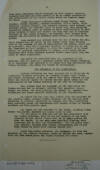
|
19.
August 26, 1930.
G-2 Translation of "Nicaraguan Women and the
Bestiality of the Marines," La Prensa,
Aug. 22, 1930, Col. Gordon
Johnston, Military Attaché,
Mexico City, p. 4.
"
. . . show their hostility
toward everyone in that Central
American republic who does not
show himself to be an ardent
partisan of the Protectorate of
the United States which was
imposed there by force. ¶ Eight
Nicaraguan citizens named Miguel
Molina, Juán Escobar, Daniel
Valdivia, Teodoro Martinez,
Julian Reyes, Julio Olivares,
Nicholás Mendoza, and Jeremías
Linares, were accused, and
although during the terrible
trial to which they were
subjected absolutely nothing
could be proven of their
participation in that crime
(nature of crime not stated) and
they were put to horrible
tortures by the Yankee marines,-
so terrible that Linares died,
mangled and martyrized by
shocking mutilations,- yet
nothing was proven. ¶ Such
scandal was aroused over the way
in which the military
authorities of David, in the
Panama Canal Zone, treated five
of the accused (as two of them,
Escobar and Méndez, could not be
captured), that the Nicaraguan
Minister in Panama had to ask
the President of that Republic
to allow the accused to be tried
before the judicial authorities
of Panama, as it could not be
tolerated that those innocent
persons should come again into
the hands of their tormentors. ¶
The crime was committed when the
paymaster of the Chiriqui Land
Co. went in a gasoline launch
from Puerto Armuelles to La
Esperanza, and although it is
known that the assailants were
Yankee marines, the crime was
blamed to Nicaraguans. ¶ New
Offensive of the Sandinistas. ¶
Another offensive has been
carried out in Nicaragua by
Sandinista elements commanded by
Generals Miguel Angel Cortez
[Miguel Angel Ortez] and Pedrón
Altamirano, with the result that
their advance in the first ten
days of August has caused
serious alarm among all the
sympathizers of the Yankee
invasion in the city of
Matagalpa. ¶ Gen. Cortez [Ortez]
took the hacienda of Río Tuma,
where the Yankee marines had an
outpost, seizing food supplies,
money, horses and mules, and
took prisoner the owner, Sr.
Ignacio Castellón, who had shown
terrible hostility to the
Sandinistas. ¶ On August 7th the
same Gen. Cortez [Miguel Angel
Ortez] took the hacienda of Don
Alberto Vogel, another Yankee
outpost, and the marines were
compelled to retreat, reporting
to Managua that the Sandinistas
were perfectly armed and
munitioned, with modern rifles
of various calibers and five
machine guns. ¶ Sr. Vogel was
not molested in the least, as,
being taken before Gen. Cortez
[Ortez], the latter said to him:
¶ “We are going to show you and
all who sympathize with the
Yankee invasion, that we are not
bandits as the news agencies of
the United States call us in
their cables all over the world.
We are only some patriots
fighting that Nicaragua may be
free and independent. You are
given absolute liberty, through
your German citizenship; but if
you were Yankee we would have
already knifed you.” ¶ Later
Gen. Cortez [Ortez] advanced,
via Matiguas, to take the
hacienda of Don Alberto
Sullivan, where he seized the
arms, ammunition and four mules,
which the Yankee marines had
there."
|
|
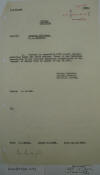
|
20.
August 22, 1930.
G-2 Translation of
"Atrocities Being Committed In
Nicaragua—The Criminal
Outrages Committed By the
Fair-Skinned Invaders In an
Unfortunate Republic Are Being
Denounced To the Civilized
World,"
La Prensa, Aug. 16
& 18, 1930, Col. Gordon Johnston,
Military Attaché, Mexico City,
p. 1.
"G-2 Report ¶ 3850: ¶ MEXICO ¶
POLITICAL ¶ SUBJECT: Foreign
Relations: ¶ C. A. SANDINO. ¶ 1.
Further in connection with
recent reports submitted under
the above subject, there is now
forwarded translation of two
articles appearing respectively
in the “Prensa” of Mexico City
on August 16 and 18, 1930. ¶
Gordon Johnston, ¶ Colonel,
Cavalry ¶ Military Attaché. ¶
Source: As stated. ¶ J/p ¶ From:
M.A.Mexico. ¶ Report No. 3054. ¶
Date: Aug. 22, 1930. . . . "
|
|
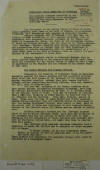
|
21.
August 22, 1930.
G-2 Translation of "Atrocities Being Committed In
Nicaragua—The Criminal
Outrages Committed By the
Fair-Skinned Invaders In an
Unfortunate Republic Are Being
Denounced To the Civilized
World,"
La Prensa, Aug. 16
& 18, 1930, Col. Gordon Johnston,
Military Attaché, Mexico City,
p. 2.
"
. . . (Translation) ¶ From La
Prensa, Aug. 16/30 ¶
Atrocities being committed in
Nicaragua ¶ The criminal
outrages committed by the
fair-skinned invaders in an
unfortunate republic are being
denounced to the civilized
world. ¶ The Government of the
United States is about to
establish a powerful naval base
in the Golf [Gulf] of Fonseca,
in Nicaraguan territory, by a
concession just granted by
President Moncada. ¶
Admiral Campbell went to Managua
a few days ago, according to
news transmitted to this capital
yesterday, and, in conference
with President Moncada, attended
by the Yankee Minister in
Nicaragua Mr. Hanna, the Chief
of the Nicaraguan National
Guard, Gen. Douglas McDougal,
and the Chief of the Yankee
marines, Col. Boardman,- Admiral
Campbell laid before President
Moncada the instruction which he
brought from the Navy Department
at Washington to proceed
immediately with the
establishment of a great naval
base in the Golf [Gulf] of
Fonseca, with or without the
permission of the Government of
Costa Rica. ¶ Admiral Campbell
stated to President Moncada that
he would proceed immediately to
the construction of that naval
base, which was necessary for
the United States in order to
have a base of operations in the
Pacific for the defense of the
Panama Canal on that side. ¶
The Yankee Marines are
Highway Robbers. ¶
Throughout the Republic of
Nicaragua there is unanimous
animosity against the Yankee
marines and the so-called
National Guard which has been
formed by the invaders of the
unfortunate Central American
republic, because they have
become veritable highway
robbers, respecting absolutely
nothing; they rob, assault, and
kill, when it pleases them. ¶
The last two offense of the
Yankee invadors [invaders] which
have caused general indignation
throughout Nicaragua, have been
the assault perpetrated
personally by Capt. H. T.
Nichols, Chief of the National
Guard of Rivas. This was an
attempt to forcibly take a
señorita, daughter of señor
Morice, to turn her over to Lt.
Standell for his mistress. When.
Capt. Nichols, pistol in hand,
broke into the home of señor
Morice and vilely insulted
señora Morice, insisting that
the señorita Morice be delivered
to him, the Yankee lieutenant,
Chirles, also pistol in hand,
went to the social club of Rivas
and threatened to kill Humberto
Morice, brother of the señorita
which the Yankee marines wanted
to prostitute. ¶ Neither
President Moncada, nor Gen.
McDougal supreme chief of the
so-called National Guard, have
paid any attention to the
protests that all the society of
Rivas have sent to them, asking,
if not the punishment of those
soulless and criminal officers
of the United States Navy,- at
least that they be removed from
the place. ¶ Gen. McDougal, with
greatest cynicism virtually told
a committee of women who visited
him to complain of those
unspeakable outrages: ¶ “A
savage Indian, as are all
Nicaraguan women, should be
honored to have an American man;
it is the greatest honor for
her.” ¶ These phrases are
considered the greatest outrage
that could be inflicted on a
Nicaraguan woman. . . . "
|
|
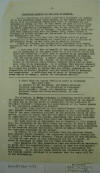
|
22.
August 22, 1930.
G-2 Translation of "Atrocities Being Committed In
Nicaragua—The Criminal
Outrages Committed By the
Fair-Skinned Invaders In an
Unfortunate Republic Are Being
Denounced To the Civilized
World,"
La Prensa, Aug. 16
& 18, 1930, Col. Gordon Johnston,
Military Attaché, Mexico City,
p. 3.
"
. . . Scandalous Assault
in the City of Managua.
¶ Another scandalous act which
shows what Americans are capable
of in the countries under their
control is the brutal assault
committed with the honorable
señora doña Lucia de Brockman
and her children on Sunday, the
3rd of this month, at nine in
the evening. It was robbery with
violence, committed by the
Yankee marines, with the added
aggravating circumstance that it
was committed in the capital
itself, the city of Managua. The
marines, their faces covered
with handkerchiefs with the
Yankee flag, robbed señora de
Brockman of fifteen dollars and
threatened to violate her
daughter and assassinate her
sons. ¶ Notwithstanding the fact
that the Yankee chief of police
captured one of the assailants,
who turned out to be an officer
of the Aviation Corps, he was
later put in absolute liberty. ¶
Señora de Brockman has
energetically denounced this
savage assault, as well as the
impunity which her assailants
enjoy, as follows: ¶ “I know
very well that an assault of
this brutal nature would not go
unpunished in the great Republic
of the United States, and those
who committed it would even be
lynched by an indignant mob; the
police would have exhausted all
their energies in finding out
the guilty persons. I cannot
understand why in Nicaragua, a
country of culture and ‘friend’
of the United States, the forces
of occupation under Admiral
Campbell allow such an enormous
crime to go unpunished. It is
perhaps that Admiral Campbell is
as criminal and soulless as his
subordinates? It appears so.” ¶
She closed her protest by saying
that she offers, placing at the
disposition of Admiral Campbell
–not for herself, but to
safeguard her compatriots- a
sufficient sum of money to
investigate the crime and, as an
example, punish the delinquent
marines. ¶ A Plane from the
United States, en route to
Nicaragua will land here. ¶
It carries no war
materials, but Yankee officers;
¶ Terrible espionage. The
situation in Nicaragua, where
Moncada’s troops are deserting,
and the American troops are
being annihilated, is very
serious. ¶ The
situation in Nicaragua is
demanding careful study by the
American Government, which is
seriously concerned by the
aspect it takes day by day, and
which is complicated by the
defection of President Moncada’s
troops, and the annihilation of
the Yankee guards by the
insurgents commanded by Sandino.
¶ The latest news received in
this capital (Mexico City)
indicate that general discontent
has taken possession of all
Nicaraguans in view of the cruel
procedure followed by the
American troops of occupation,
to such an extent that now the
Yankee authorities show lack of
confidence in their own troops,
exercising very severe espionage
to avoid ambush and treason from
their own functionaries. ¶ The
news received in Washington are
so alarming in this respect that
the Government of the White
House has decided to send a band
of scouts, that by means of
airplanes they can learn the
true conditions of the American
marines and Sandino rebels, by
making flights over the
territory dominated by the
latter. ¶ In effect, we are
reliably informed that the
American Government, through
proper channels, has requested
the Mexican authorities to
permit a Yankee Marine trimotor
“Fokker”, piloted by Capt.
Mulcanny, to land at some point
in this country, at the end of
August, en route to Nicaragua to
carry out its first scouting
flights. ¶ Upon applying for
this permission from our
authorities assurance is given
that the apparatus (plane)
carries no arms nor photographic
materials (cameras), but that
the landing will be principally
for refuelling [refueling]. It
is not yet known whether our
Government will give the desired
permit, although it is assured
that the reply will be in the
affirmative. . . . "
|
|
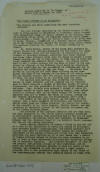
|
23.
August 22, 1930.
G-2 Translation of "Atrocities Being Committed In
Nicaragua—The Criminal
Outrages Committed By the
Fair-Skinned Invaders In an
Unfortunate Republic Are Being
Denounced To the Civilized
World,"
La Prensa, Aug. 16
& 18, 1930, Col. Gordon Johnston,
Military Attaché, Mexico City,
p. 4.
"
. . . (Translation) ¶ Article
appearing in “La Prensa” of
Mexico City on August 18, 1930.
¶ “THE YANKEE INFERNO IS
IN NICARAGUA”. ¶ “The Marines
are still committing the most
atrocious outrages.” ¶
The last outrage committed by
the Yankee marines in the city
of Rivas, second in importance
in Nicaragua, which aroused such
indignation among all social
classes of the nation,- that of
carrying off, by force, the
beautiful señorita Maria Teresa
Morice, almost a child, from her
father’s home, to be given over
to Lieut. Stanley,- culminated
in a further outrage perpetrated
by the Yankee marines against
the Italian flag, which insult
the American Minister, Mr.
Hanna, is vainly attempting to
repair. ¶ Sr. David Morice,
father of the young girl
abducted by United States Navy
officers, denounced the act
before the Judge of the Criminal
Court and the Minister of
Gobernacion in the Cabinet of
President Moncada, declaring
that Capt. Nichols and three
other officers broke into his
house at eleven o’clock Sunday
morning, the 3rd of this month,
to take away by force his young
daughter the señorita Maria
Teresa. Sr. Morice stated that
it was a brutal outrage and the
more so since it was committed
by officers of the National
Guard which he understood had
been instituted for the
protection of citizens, and not
to threaten and scandalize, as
they had done. He stated that he
was an Italian, and had told
these officers so, and even
placed the flag of his country
at the door of his inside rooms,
but the marines replied that the
Italian flag meant nothing to
hem, and they passed on in,
treading upon the flag. ¶ The
marines upon meeting such
energetic resistance, called in
other officers, and Lt. Stanley
and Lt. Kesseler came to their
aid, with a picket of National
Guards of native Nicaraguans,
and they proceeded to slap and
insult women and children. Capt.
Nichols even ordered a picket of
seven Nicaraguan Guards to shoot
upon the Morice family, when
señora Hercillia Gaboardi fell
on her knees before the Guards
and implored them not to commit
the crime of firing, crying “Let
the Yankee assassinate; you are
Nicaraguans; don’t fire.” ¶ The
mother of don David Morice, an
old woman of over eighty, also a
small daughter of Sr. Morice,
had already received blows from
the Yankee officers. Sr. Morice
has reported the atrocity to Dr.
David Campari, Italian Consul,
who has presented an energetic
protest to the Moncada
Government and to the Yankee
Minister, Hanna. ¶ The outrages
of the American officers did not
stop here, but they kidnapped
Dr. don Adolfo Morice, recently
graduated in Philadelphia,
because they surprised him in
the act of sending telegrams, a
few minutes after the incident,
to President Moncada and Gen.
McDougal, Chief of the National
Guard, denouncing the act and
asking guarantees. ¶ These
attacks, committed at eleven
o’clock in the day and in a city
of the importance of Rivas, the
second in Nicaragua, have
provoked general consternation,
and bitter protests have already
been sent to President Moncada
asking the energetic punishment
of the guilty persons, and at
the same time demanding
guarantees for many families, as
it is well known that a number
of Yankee officers intend to
follow the same procedure in
order to take as their
mistresses, distinguished
señoritas belonging to honorable
families. The American Minister,
in face of the general
indignation aroused by this
abduction, and to quiet the
terrible protests pouring in
from all parts of the country,
has attempted to give the matter
a legal aspect, claiming that it
was perpetrated upon orders of
the Judge of the Department, who
ordered that Señorite [Señorita]
Morice be taken from . . . "
|
|
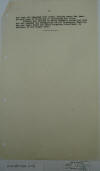
|
24.
August 22, 1930.
G-2 Translation of "Atrocities Being Committed In
Nicaragua—The Criminal
Outrages Committed By the
Fair-Skinned Invaders In an
Unfortunate Republic Are Being
Denounced To the Civilized
World,"
La Prensa, Aug. 16 & 18,
1930, Col. Gordon Johnston,
Military Attaché, Mexico City,
p. 5.
"
. . . her home and demanded that
Lieut. Stanley marry her
immediately, even if divorcing
or abandoning her later. ¶
Stanley was obliged to marry
Señorita Morice, but this has
not checked the indignation of
all Nicaraguan families, who see
their honor and their daughters
threatened, by officers of the
Yankee Navy."
|
|
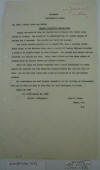
|
25.
August 20, 1930. G-2
Report on Guardia Activities
During July, Lt. Col. Fred T.
Cruse, Military Attaché, San
José.
"NICARAGUA
¶ POPULATION & SOCIAL ¶ No. 2700
– Public Order and Safety. ¶
Guardia activities during July.
¶ During the month of July the
Guardia had 14 fights with
rather large groups of bandits.
The result of the encounters was
19 bandits killed, 17 wounded
and 8 captured. The guardia had
three men wounded. ¶ The latest
contact reported was on August
7th, near a locality called
Nance Dulce, in the Northern
Area, where a patrol of Guardia
Nacional attacked a group of 45
bandits headed by Pedro Salgado.
Six bandits were killed and two
captured, but Salgado got away.
Among those killed were two
minor chiefs of Sandino known as
General Button and Colonel
Pulmazon. ¶ After the fight the
patrol commander sent a small
detachment to reconnoitre the
vicinity and they found six
wounded bandits who had been
left behind. All of them died
before they could be brought in
to the detachment station. ¶ All
indications are that Sandino
himself is in the vicinity of
Totecasinte, and that he does
not dare to come very far into
Nicaraguan territory. ¶ Report
No. 848 ¶ San José--August 20,
1930 ¶ Source – Newspapers. ¶
Fred T. Cruse, ¶ Major, G.S. ¶
M.A."
|
|
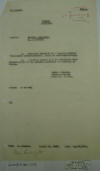
|
26.
August 19, 1930. G-2
Report on Nicaraguan
Revolutionists, Col. Gordon
Johnston, Military Attaché,
Mexico City, p. 1.
"G-2
Report ¶ 3850-a ¶ MEXICO ¶
POLITICAL ¶ SUBJECT: Foreign
Relations ¶ C. A. SANDINO ¶ 1.
Forwarded herewith is a report
entitled “Nicaraguan
Revolutionists”, which is
self-explanatory. ¶ 2. A further
report will be submitted, after
investigation of the persons
mentioned as residing in Mexico.
¶ Gordon Johnston ¶ Colonel,
Cavalry ¶ Military Attaché. ¶
Source: As stated. ¶ J/p ¶ From:
M.A.Mexico. ¶ Report No. 3049. ¶
Date: Aug. 19, 1930. . . ."
|
|
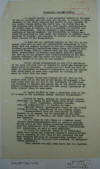
|
27.
August 19, 1930. G-2
Report on Nicaraguan
Revolutionists, Col. Gordon
Johnston, Military Attaché,
Mexico City, p. 2.
"
. . . Nicaraguan Revolutionists.
¶ On August 15, 1930 a man
presented himself at the home of
the M/A stating that his name
was Lt. Col. S. Valero, a Cuban,
formerly of the Cuban Army, and
had served in some capacity in
the United States during the
World War. He stated that he was
intimate with friends of Dr.
José Zepeda, representative of
Sandino here in Mexico, and in a
position to furnish valuable
information. Also he proposed a
plan whereby an expedition, of
limited numbers, say twenty-five
or thirty men, could be
organized in Cuba under the
pretense of offering their
services to Sandino, and
engaging to capture or kill him
upon their arrival at his
headquarters. ¶ As this man was
entirely unknown to the M/A, he
was herely told that we were not
particularly interested in
Sandino; that the country
occupied by him was a wild,
mountainous district,
practically uninhabited, where
there had always been guerrilla
bands; that if Sandino were not
the leader, some other
“guerrillero” of similar type
would take his place; and that
up to the present time Sandino,
outside of his propaganda
activity, has not shown any such
qualities as a military leader
as to give us any concern. ¶
Valero seemed disappointed at
the M/A’s statement of the case
and said that he thought he
could get information which
would be valuable. In reply, the
M/A told him that we might be
interested in accurate
information as to the sources
from which money or arms were
supplied to Sandino, and the
means by which this was done. ¶
Although Valero had assured the
M/A that he was without work and
at the end of his means, it
happened a few days later that
the M/A was in the Department of
Education and happened to
observe him coming out of one
office and entering another,
without his hat, and with every
appearance of being engaged
there is some work. ¶ On August
16, 1930 he left a pencilled
[penciled] note at the M/A’s
home to the following effect
(literal translation): ¶ “Rafael
de Egaña, citizen of Nicaragua,
in Havana, furnished all kinds
of news items which favor
Sandino. ¶ “Dr. Alvaro
Caldevilla, Edificio Carreño,
Cuban, 22; representative of
Sandino in Cuba. ¶ “Abelardo
Besada, confidential agent of
the United States in Havana,
sympathizer of the Sandino
cause. ¶ “Correspondence does
not come direct to Mexico,
because it is opened, but is
deposited in the mail boxes on
board, in Managua, and other
times via Havana and Honduras. ¶
“In San Pedro de Sula there is a
Mexican named Joaquin
Bustamente, employed with an
American company who, by means
of this company, received
correspondence; soon two
individuals will leave, carrying
instructions and ammunition, as
well as some medicines. ¶ At
Calle St. Tomás, 44, there is an
individual named Luis Montes who
informed Sandino’s
representative of the presence
in Vera Cruz of two Americans
who had been assigned the task
of assassinating Sandino, but
they refused to do this, and
have revealed “la incognita”
(their identity). ¶ “Four
persons who will soon leave for
Las Segovias . . . "
|
|
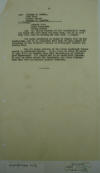
|
28.
August 19, 1930. G-2
Report on Nicaraguan
Revolutionists, Col. Gordon
Johnston, Military Attaché,
Mexico City, p. 3.
"
. . . are: Alfredo O. Medina, ¶
José Piat ¶ Manuel Torres ¶
Roberto G. Treviño. ¶ In Havana:
¶ Antonio Díaz ¶ Cesar Hernandez
¶ Carlos Fustes ¶ and Lt. Odalio
Herrera of the Presidential
Guard are those who gave help
and sent arms, and it is said
they will soon be leaving Cuba
with a cargo.” ¶ The names
mentioned as being in Mexico
will be investigated, and it its
suggested that copy of this
report be forwarded to the
Military Attaché at Havana, for
similar investigation. ¶ The M/A
knows nothing of the above
mentioned Valero except as
indicated herein. He is a man of
about 45 years of age; 5’10” in
height; very well dressed, and
of intelligent expression. M/A
judges him to be about half
Spanish. He gave no other reason
for furnishing the above
information than that he desired
payment therefor."
|
|
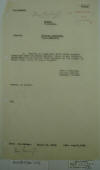
|
29.
August 15, 1930.
G-2 Translation of "Relatives of Sandino and Other
Rebel Chiefs, Tortured," La
Prensa, Mexico City, Aug 14, Col.
Gordon Johnston, Military
Attaché, p. 1.
"G-2
Report ¶ 3850-a ¶ MEXICO ¶
POLITICAL ¶ SUBJECT: Foreign
Relations: ¶ C. A. SANDINO. ¶ 1.
Further in connection with
recent reports submitted under
the above subject, there is now
forwarded translation of an
article which appeared in “La
Prensa” of Mexico City, issue of
August 14, 1930. ¶ Gordon
Johnston, ¶ Colonel, Cavalry, ¶
Military Attaché. ¶ Source: As
stated. ¶ J/p ¶ From:
M.A.Mexico. ¶ Report No. 3045. ¶
Date: Aug. 15, 1930. . . . "
|
|
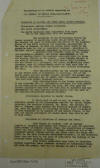
|
30. August 15, 1930.
G-2 Translation of "Relatives of Sandino and Other
Rebel Chiefs, Tortured," La
Prensa, Mexico City, Aug 14, Col.
Gordon Johnston, Military
Attaché, p. 2.
"
. . . Translation of an article
appearing in “LA PRENSA” of
Mexico City, Aug. 14, 1930. ¶
RELATIVES OF SANDINO AND
OTHER REBEL CHIEFS, TORTURED. ¶
Nicaraguans destroy Yankee
airplanes. ¶ The jails
overcrowded. ¶ The North
Americans deal rigorously with
those who do not sympathize with
the invaders. ¶ The
hostility of the Nicaraguans
toward the Yankee invaders is
manifested every day, in every
way, and has reached the point
of disabling the motors of the
gigantic planes of the North
American Air Squadron,
headquarters in the city of
Managua, so that the planes
shall smash to the ground, or
burn up, and be completely
useless,- according to reliable
reports received yesterday in
Mexico, from Nicaragua. ¶ A
gigantic Ford trimotor plane of
the Yankee Air Squadron, in
Managua, was burned upon landing
on the Ocotal landing-field, the
accident occurring when the
plane was already running on the
ground; upon turning sharply to
one side, it overturned. The
millionaire John B. Stetson who
was aboard as a passenger, the
pilot, co-pilot, and radio
operator, were all miraculously
saved as they were able to get
out of the cabin when the flames
were already destroying the
ship. ¶ This tri-motor, which
was the largest belonging to the
Yankee army of occupation in
Nicaragua, was of the latest
model and had reached Managua
scarcely two months ago. Its
entire structure was of metal,
with high-powered motors, and
cost over eighty thousand
dollars. ¶ From investigations
by the Yankee authorities, it
was revealed that an inflammable
substance had been poured on the
motor, which originated the
fire, but even upon the closest
inquiries they have not been
able to discover who was
responsible for this disaster
which nearly cost the life of
the American millionaire
magnate, Stetson. ¶
Nicaraguans deported to deadly
Alaska. ¶ In their zeal
to put an end, by terror, to the
hostility latent in all
Nicaraguans against the odious
Yankee invasion, the American
Minister, Mr. Hanna, and Captain
Alfred W. Johnson, have adopted
the terrible measure of
deporting, with the approval of
President Moncada, such
Nicaraguans as were suspected to
be enemies of the United States,
to the cold and deadly
peninsular of Alaska, where they
will be put to hard labor. ¶
Martyrdom of relatives
of Sandino and Ortez. ¶
Doña Blanca de Sandino, wife of
General Augusto C. Sandino; his
mother and sister; as also don
Salvador Ortez, father of
General Miguel Ortez; the
grandfather of General Ortez;
and the mothers of General
Pedrón Altamirano and of the
insurgent chiefs Avelino Herrera
and Pedro Loyo; are being
subjected to the most atrocious
martyrdom (tortures), in the
seclusion where they are held in
the city of León, under the
custody of the soulless North
American marines. ¶ Such bitter
complaints were taken to
President Moncada regarding
these infamous tortures to
defenceless women and sick old
people, that he was obliged to
call a Council of . . . "
|
|
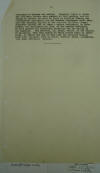
|
31. August 15, 1930.
G-2 Translation of "Relatives of Sandino and Other
Rebel Chiefs, Tortured," La
Prensa, Mexico City, Aug 14, Col.
Gordon Johnston, Military
Attaché, p. 3.
"
. . . Ministers to discuss the
matter. Senators Victor M. Román
and Heliodoro Robleto were
present at this meeting, and
although an attempt was made to
place in absolute liberty the
“confinados” (prisoners),- as
the Moncada Government calls
them, this was strongly opposed
by the American Minister, Hanna;
therefore Moncada had to issue a
decree prolonging, by three
months, the confinement, in
León, of the persons mentioned,
as this measure was considered
necessary for the health of the
Republic. The Minister, Mr.
Hanna, stated, at the Council of
Ministers, that this period of
three months would be
sufficient, as before the end of
that time the American marines
would have captured, dead or
alive, Sandino, Ortez,
Altamirano, and their principal
leaders."
|
|
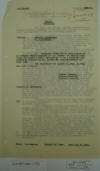
|
32. August 12, 1930.
G-2 Translation of "Bulletin from Dr. Pedro José
Zepeda," La Prensa &
El Excelsior, Mexico
City, Aug 9, Col. Gordon
Johnston, Military Attaché, p.
1.
"G-2
Report ¶ 3850-a ¶ MEXICO ¶
POLITICAL ¶ SUBJECT: Foreign
Relations: ¶ C. A. SANDINO ¶ 1.
Forwarded herewith is
translation of an article which
appeared in “La Prensa” of
Mexico City, issue of August 9,
1930, purporting to be a
bulletin furnished by Sandino to
Dr. Zepeda, his representative
in this city. ¶ “El Excelsior”
of August 10, 1930, carried the
same article. ¶ Gordon Johnston,
¶ Colonel, Cavalry, ¶ Military
Attaché. ¶ Source: As indicated.
¶ J/p ¶ From: M.A.Mexico. ¶
Report No. 3037. ¶ Date: Aug.
12, 1930. . . . "
|
|
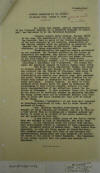
|
33. August 12, 1930.
G-2 Translation of "Bulletin from Dr. Pedro José
Zepeda," La Prensa &
El Excelsior, Mexico
City, Aug 9G-2 Translation of , Col. Gordon
Johnston, Military Attaché, p.
2.
"
. . . (Translation) ¶ Article
appearing in “La Prensa” of
Mexico City, August 9, 1930. ¶
Dr. Pedro José Zepeda, general
representative of the “Ejercito
Defensor de la Soberania
Nacional de Nicaragua”, has
delivered to us the following
bulletin: ¶ “General Augusto
César Sandino, Supreme Chief of
the Army, has communicated to me
from his camps in the Segovias,
that in spite of the furious
bombardment of the zone occupied
by our soldiers, organization of
the various columns which are
preparing an energetic offensive
over the sectors of Matagalpa,
Jinotega and Chontales, is being
successfully carried out. ¶
Notwithstanding the complete
reserve maintained by the
invaders, the reverses suffered
by the forces of occupation are
numerous, they having lost in
nearly all their encounters,
their field officers and other
officers. In the last combat of
“Ojoche”, Capt. James Parker
Schwerin was mortally wounded,
and 17 marines were killed,
including 1 lieutenant and 2
sergeants. Our column was under
the immediate command of General
Miguel Angel Ortez. ¶ “The first
battle effectively fought, and
which is without doubt the most
bloody of this second stage of
our struggle for the liberty of
Nicaragua, took place in San
Pedro, a few miles from the
Honduran border. Notwithstanding
our enemies used machine guns,
hand grenades and gases, after
seven hours of furious fighting
the invaders took refuge in
Concepción del Norte, in
Honduran territory. General
Sandino, in order to avoid
pretexts which should serve the
enemy in violating the
sovereignty of this brother
country, ordered the immediate
reconcentration of our
effectives toward the interior
of Nicaragua. In this encounter
there were 15 killed on our
side, and 19 seriously wounded
by explosive bullets. The enemy
losses could not be estimated
because they were able to carry
off their wounded, but they left
23 killed on the field. ¶
“Patrols (“patrullas”) of our
Army have appeared in Pozoltega,
Department of León, and in Santa
Teresa, Department of Carazo. ¶
“Our military hospital,
established on the heights of
Cerro Yucapuca, in Jinotega, was
set on fire by a bomb hurled
from an airplane, and a wounded
patient was burned to death as
on account of his grave
condition it was not possible to
save him. ¶ “A new Corsair
combat plane of the United
States Navy was obliged to land
in Ticuantepe, ten miles from
Managua. In the resulting crash
the pilots were killed, also
artillerymen Walter A. Pounders
of Colt, Arkansas, and Lieut.
Chaimbers Martin of Barlow,
Ohio. Their bodies were
respected, as also all their
papers of identification,- this
conduct contrasting with that of
the invaders who systemically
decapitated our dead soldiers
and carried the heads on the
points of their bayonets. The
Commander of our column reports
that the plane was smashed to
splinters.”"
|
|
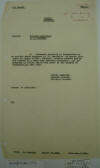
|
34. August 8, 1930.
G-2 Translation of "Sandino Relates How He Was
Wounded By A Bomb From American
Airplanes," El Excelsior,
Mexico City, Aug. 5, Col. Gordon
Johnston, Military Attaché, p.
1.
"G-2
Report ¶ 3850-a ¶ MEXICO ¶
POLITICAL ¶ SUBJECT: Foreign
Relations: ¶ C. A. SANDINO. ¶ 1.
Forwarded herewith is
translation of an article which
appeared in “El Excelsior” of
Mexico City, issue of August 5,
1930, entitled “Sandino Relates
how he was wounded by a bomb
from American airplanes”, and
describing an action which took
place on the heights of
Saraguazca, on June 19th. ¶
Gordon Johnston, ¶ Colonel,
Cavalry, ¶ Military Attaché. ¶
Source: As indicated. ¶ J/p ¶
From: M.A.Mexico. ¶ Report No.
3031. ¶ Date: Aug. 8, 1930. . .
. "
|
|
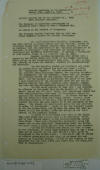
|
35. August 8, 1930.
G-2 Translation of "Sandino Relates How He Was
Wounded By A Bomb From American
Airplanes," El Excelsior,
Mexico City, Aug 5, Col. Gordon
Johnston, Military Attaché, p.
2.
"
. . . Article appearing in “El
Excelsior” ¶ Mexico City, August
5, 1930. ¶ SANDINO
RELATES HOW HE WAS WOUNDED BY A
BOMB FROM AMERICAN AIRPLANES. ¶
The Defender of Nicaraguan
Sovereignty is Operating with a
Group of over a Thousand Men. ¶
An Action on the Heights of
Saraguazca. ¶ The Tireless
Warrior Declares that he will
Continue fighting against the
Moncada Government. ¶
Sr. José Constantino González,
Nicaraguan, who has just arrived
in Mexico, coming from San
Salvador, brings an autograph
letter from General Augusto
César Sandino, in which he
declares that the operations of
the “Ejercito Defensor de la
Soberanía de Nicaragua” (Army
Defending the Sovereignty of
Nicarauga) are perfectly
satisfactory. We produce a
facsimilie [facsimile] of this
letter, dated in Las Segovias
June 26, 1930. ¶ General Sandino
accompanied this letter with a
report on the battle which took
place in the rugged mountains
which served as his
headquarters, on June 19th. In
this encounter, details of which
are unknown, Sandino was
wounded, though not seriously. ¶
“On the Segovian plains and
mountains our shots of protest
have not ceased and will not
cease”, states the ‘comunicado’
(report). “On the extensive
plains of Las Segovias there
are, among others, two imposing
heights,- ‘El Saraguazca’ and
‘El Yucapuca’, which were our
centres of operation during the
war against Chamorro and Diaz,
in 1927. For the purpose of
developing new plans of our Army
I took possession of ‘El
Saraguazco’, with 400 men and 10
machine guns, on June 18th,
leaving other columns, numbering
over 600 men, strategically
placed at different points. ¶
“In the early morning of June
19th I was informed by officers
of the guard that on the heights
of ‘El Chirinagua’ and on the
‘La Cruz’ bluff, that suspicious
lights had been seen, descending
down upon ‘El Saraguazca’,
trying to approach our first
outposts. We looked through the
fog and found that they were
enemy lights. General Pedro
Altamirano, officer of the day,
came up hurriedly with ten
mounted men, with the same
report as to the proximity of
the enemy. The signal was
immediately given for our
reserves to cover ‘El
Saraguazca’. Early in the day
fighting opened on the San
Marcos side, and by noon the
enemy had been defeated on all
its flanks, after the death in
the first attack, of the
American leader. ¶ “A fleet of 6
airplanes took part in the
fight. They used bombs and
machine guns on us, furiously,
twice, and in that tragic moment
of our history, stirring scenes
took place. There were
innumerable casualties among the
enemy, and on our side, Capt.
Encarnación Lumbi was killed and
Roque Natey, a young soldier
from Telpaneca, was wounded. ¶
“As the air bombing was ceasing,
at four o’clock in the
afternoon, an enemy bomb
exploded near me and a fragment
hit me lightly in the left leg,
but I have given no importance
to the slight wound. I was still
able to attend to affairs
pertaining to our Army, as my
wound did not prevent my
horseback riding. At six in the
evening of that memorable day
the last shots were heard from
the enemy, who fled in
desperation.” . . . "
|
|
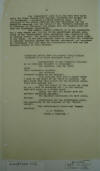
|
36. August 8, 1930.
G-2 Translation of "Sandino Relates How He Was
Wounded By A Bomb From American
Airplanes," El Excelsior,
Mexico City, Aug 5, Col. Gordon
Johnston, Military Attaché, p.
3.
"
. . . The “comunicado” goes on
to say that four hours after the
fight Sandino, with his men,
abandoned the heights of “El
Saraguazca”, according to their
previous plan. He has mobilized
to the places offering the best
facilities for the guerrilla
campaign, and the forces of the
“Ejercito Defensor de la
Soberania de Nicaragua” are
spread over Las Segovias and the
León and Chinandega Departments.
¶ The combat, lightly referred
to in the comunicado, was a very
bloody one, but due to the
magnificent natural positions of
the “Sandinistas” their
casualties were singularly few,
as already stated. The famous
“guerrillero” does not again
alude [allude] to his wound. In
the most vigorous terms he
ratifies his intention to
continue fighting against the
Moncada government, and
expresses his confidence that
very soon the Nicaraguans will
have won the complete liberty of
their country. ¶ (Autograph
letter from Gen. Augusto César
Sandino referred to in first
paragraph above.) ¶
“Headquarters of the ‘Ejercito
Defensor de la Soberania
Nacional de Nicaragua’. ¶ Las
Segovias, June 26, 1930. ¶ Señor
¶ José Constantino González, ¶
San Salvador. ¶ Esteemed brother
of the country: ¶ With this, you
will find a report which I send
to the press of the world in
general. You will learn from
this report how our military
operations were carried out. ¶
Only two copies of the report
are going out, as I have no
secretary and I am not feeling
very well owing to a slight
wound. ¶ Kindly see that the
report gets the greatest
publicity possible. ¶ Our
military operations are most
satisfactory. ¶ Salutations for
the Salvadorean press, and
especially to the Director of
the “Diario Latino”. ¶ Your
affectionate friend and “seguro
servidor”, ¶ A. C. Sandino. ¶
Patria y Libertad.”"
|
|
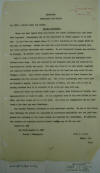
|
37. August 8, 1930. G-2 Report on Bandit Situation in
Nicaragua, Lt. Col. Fred T.
Cruse, Military Attaché, San
José.
"NICARAGUA
¶ POPULATION AND SOCIAL ¶ No.
2700 – Public Order and Safety.
¶ Bandit Situation. ¶ Since the
last report from this office the
bandit situation has been
somewhat improved. Practically
all of the the Department of
Esteli appears to be safe now.
In fact the only region where it
is still dangerous is the region
North of the City of Jinotega.
Within the last two weeks
Guardia Nacional patrols have
had three serious encounters
with bandits. In one Lieutenant
Freeman was seriously wounded.
In another three bandits were
captured and several killed. ¶
Late in July a Guardia Nacional
Patrol finally located and
destroyed Altamirano’s main
camp. This was located in the
Guapinol area and had remained
undiscovered for nearly two
years. The camp was found to be
very poorly supplied and
captured bandits stated that the
200 men in the band had only
about 15 cartridges a piece.
They further stated that Ortez
had gone to Nueva Segovia for
ammunition but had returned
without any. The latter
undoubtedly went after some of
Sandino’s supply, buried in the
vicinity of Murra, but this area
is now so closely watched that
it is doubtful if he could get
away with any. ¶ About two weeks
ago Colonel Ramón Lopez y Lopez,
Jefe Politico of Esteli,
disappeared while en route to
León. It was suspected that he
had been killed by bandits, and
this turned out to be the fact.
The group who assasinated
[assassinated] him was captured
a few days ago near Posoltega. ¶
The Guardia Nacional continues
to show excellent results. In
one of the fights near Jinotega
the patrol was commanded by
Lieutenant Delgadillo, who had
just completed his training at
the Cadet School and received
his commission. He defeated the
bandits and captured several
without losing any of his own
men. Report No. 826 ¶ San
José--August 8, 1930 ¶ Source –
Newspapers ¶ Fred T. Cruse, ¶
Major, G.S. ¶ M.A."
|
|
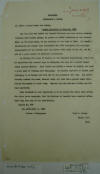
|
38.
July 1, 1930. G-2 Report
on Bandit Situation on June 30,
1930, Lt. Col. Fred T. Cruse,
Military Attaché, San José.
"NICARAGUA
¶ POPULATION & SOCIAL ¶ No. 2700
– Public Order and Safety. ¶
Bandit Situation on June 30,
1930. ¶ For the last two months
the Guardia Nacional has been
having numerous contacts with
bandit groups, in places as
widely scattered as the Bonanza
Mine, on the Coco River, to the
vicinity of the town of León.
The bands encountered are larger
than heretofore met with
throughout the campaign.
Detachments of the Guardia have
had fights with bands of 30, 40,
and 50 men in a great number of
different localities. ¶ As
showing the state of feeling in
the Northern Departments, there
was on exhibition for several
days in Matagalpa the head of a
bandit leader named Silbino
Herrera. This leader had killed
a number of people, and done a
great deal of looting near
Matagalpa. He finally captured
an Indian girl belonging to an
Indian and took her to the
mountains with him. The girl’s
husband trailed the band,
located them, and then led a
patrol under Lieutenant
Pennington to their camp.
Herrera and six men were killed
and the band scattered. ¶ This
incident is very important as it
is almost the first time during
the three years campaign, that
the Marines or Guardia have
received effective help from any
of the inhabitants. ¶ Report No.
777 ¶ San José--July 1, 1930 ¶
Source – Newspapers ¶ Fred T.
Cruse, ¶ Major, G.S. ¶ M.A."
|
|
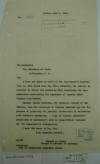
|
39.
July 1, 1930. Letter from
Chargé d'Affaires ad interim
Edward P. Lowry, Mexico City, to
Sec. State, Washington D.C., p.
1.
"Mexico,
July 1, 1930. ¶ No. 2588 ¶ The
Honorable ¶ The Secretary of
State, ¶ Washington, D. C. ¶
Sir: ¶ I have the honor to refer
to the Department’s instruction
No. 1161 dated June 21, 1930,
directing the Embassy to
endeavor to obtain all available
data concerning the
circumstances surrounding the
departure of Augusto César
Sandino from Mexico. ¶ Colonel
Gordon Johnston, the Military
Attaché of the Embassy, sent his
assistant to Yucatan sometime
ago for the purpose of gathering
all possible information in
connection with Sandino’s
movements. A copy of Colonel
Johnston’s memorandum of
yesterday’s date is respectfully
enclosed for the Department’s
information. ¶ I have the honor
to be, Sir, ¶ Your obedient
servant, ¶ EPL/kk ¶ Edward P.
Lowry. ¶ Chargé d’Affaires ad
interim. ¶ Enclosure: ¶ Copy of
memorandum described above. . .
. "
|
|
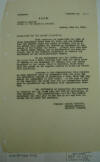
|
40.
July 1, 1930. Letter from
Chargé d'Affaires ad interim
Edward P. Lowry, Mexico City, to
Sec. State, Washington D.C., p.
2.
"
. . . Enclosure ¶ Despatch No.
2588 ¶ C O P Y. ¶ AMERICAN
EMBASSY ¶ OFFICE OF THE MILITARY
ATTACHE. ¶ Mexico, June 30,
1930. ¶ MEMORANDUM FOR THE
CHARGÉ D’AFFAIRES: ¶ With
reference to memorandum No. 1161
of State Department dated June
21, 1930, you are informed that
the current rumor and report in
Mexico City is to the effect
that Sandino was carried to
Guatemala by Col. Lezama of the
Mexican Air Force. Efforts have
been made to verify these
rumors, but no confirmation has
been obtained, nor is the
evidence sufficient to warrant
any confidence in the
above-mentioned rumors. ¶ My own
conclusions are that Sadino
[Sandino] and his party took a
small coasting boat from the
north coast of Yucatan or the
northwest of Quintana Roo, and
thence proceeded to the Patuca
River in Honduras, which would
give him access to the Segovia
country in which his forces were
operating. ¶ Previous to his
disappearance from Progreso he
made numerous trips by
automobile with his party for
the ostensible purpose of
purchasing a farm, until his
community was accustomed to such
trips. At the time of year of
his departure the roads were dry
and automobiles could move in
practically any direction with
considerable freedom. ¶ The
difficulty of concealing his
departure by airplane for any
place near his base of
operations, is very apparent.
The probabilities are that the
Mexican Government was very glad
to see him go and may have
assisted him in every way
possible. ¶ (Signed) GORDON
JOHNSTON, ¶ Colonel, Cavalry, ¶
Military Attaché."
|
|
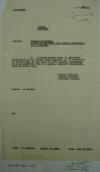
|
41. June 30, 1930.
G-2 Translation of "Sandino Not Wounded — Several
Towns Of Nicaragua Destroyed By
Machine Guns of the Americans —
Women In Jail — Mother,
Mother-In-Law, Wife, and Sister
of Sandino Are Under Arrest,"
El Excelsior, Mexico
City, June 26, Col. Gordon
Johnston, Military Attaché, p.
1.
"G-2
Report ¶ 3850-a ¶ MEXICO ¶
POLITICAL ¶ SUBJECT: Foreign
Relations: ¶ Status of Relations
with Foreign Countries: ¶ C. A.
SANDINO. ¶ 1. Attached hereto
there is forwarded translation
of an article which appeared in
“EL EXCELSIOR” of Mexico City,
in its issue of June 26, 1930,
purporting to be an interview
with Dr. Zepeda, Sandino’s
representative in Mexico City. ¶
Gordon Johnston, ¶ Colonel,
Cavalry, ¶ Military Attaché. ¶
Source: As stated. ¶ J/p ¶ From:
M.A.Mexico. ¶ Report No. 2963. ¶
Date: June 30, 1930. . . . "
|
|
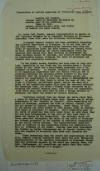
|
42. June 30, 1930.
G-2 Translation of "Sandino Not Wounded — Several
Towns Of Nicaragua Destroyed By
Machine Guns of the Americans —
Women In Jail — Mother,
Mother-In-Law, Wife, and Sister
of Sandino Are Under Arrest,"
El Excelsior, Mexico
City, June 26, Col. Gordon
Johnston, Military Attaché, p.
2.
"
. . . (Translation of article
appearing in “EXCELSIOR” June
26, 1930) ¶ Sandino Not
Wounded. ¶ Several towns of
Nicaragua destroyed by machine
guns of the Americans. ¶ Women
in Jail. ¶ Mother,
mother-in-law, wife, and sister
of Sandino are under arrest.
¶ Dr. Pedro José Zepeda, general
representative in Mexico of the
“Ejercito Defensor de la
Soberania Nacional de
Nicaragua”, yesterday (June
25th) made the following
declarations: ¶ “Although
General Sandino has been
personally directing the
military operations in
Nicaragua, it is not true that
he has been wounded. In
communications received here
from the field of operations
dated the 20th instant, the
General tells me that,
notwithstanding the fierce
bombardment which the American
Navy planes have been carrying
on throughout the whole northern
sector of Jinotega, our soldiers
have suffered no considerable
losses, although the towns of
Rinconada and Montaña were
completely destroyed. ¶ “In the
Esteli sector fighting has been
more or less violent, especially
in San Diego and San Antonio,
where a flying column of Gen.
Ortez had a hard-fought
encounter with a detachment of
Marines. In General Sandino’s
official report it is especially
emphasized that our forces
avoid, so far as possible,
attacking the national guards
because it has been confirmed
that the majority of these
national guards are seeking the
opportunity to enter the ranks
of our army. As proof of this
there is cited the case of Col.
Enrique S. Tijerino, ex-national
guard, who, at the head of a
group of his companions, opened
fire upon the American officers
who commanded them, and after a
bloody fight succeeded in
carrying off several machine
guns, some rifles and
ammunition, with which they have
been able to form a strong
nucleus in Ometepec, now under
the orders of General Sandino. ¶
“Confirmed reports from San
Rafael del Norte state that a
group of American officers under
Capt. Fleming who is called
commandante of the “Central de
Policia”, after committing all
kinds of outrages, captured the
wife of General Sandino, and the
old mother of General
Altamirano. Those women, as well
as the mother and elder sister
of Doña Blanca Aráuz de Sandino,
were taken as prisoners to
Managua. After subjecting them
to all sorts of penalties they
were later taken to León where
they are now held incomunicado
[incommunicado] in the jail of
that town which is under the
forces of the occupation. The
outrages which are being
committed throughout the whole
of the north of Nicaragua are
without precedent in the history
of arbitrary occupations of the
United States Marines. The
assassinations committed daily
by soldiers of the occupation
forces are numberless, as well
as offenses of all kinds.
Feeling runs high throughout the
country as worthy Nicaraguans
see in General Sandino the only
man capable of redeeming them
from such ignominy and shame. ¶
“Upon commenting upon the arrest
and imprisonment of his wife,
General Sandino considers that
those who call themselves
representatives of the American
Government in Nicaragua forget
that all civilized peoples in
the world are judging them, and
that, furthermore, all
sacrifices are noble when they
serve the cause of the liberty
of a people.”"
|
|
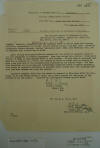
|
43. June 26, 1930. G-2 Report on Sandino's Connection
with Communist Party of Mexico,
Lt. Col. Fred T. Cruse, Military
Attaché, San José.
"G-2
¶ CGM/BC ¶ EVALUATION OF REPORTS
FROM M/A, Guatemala. ¶ MILITARY
INTELLIGENCE DIVISION. ¶
EVALUATED IN Latin American
Section. ¶ DATE June 26, 1930. ¶
Number of Report ¶ I.G. Number ¶
Remarks as to value of
information contained. ¶ The
attached report is forwarded for
your information and comment.
(Report No. 2948, from M/A,
Mexico, June 17, 1930.) ¶
COMMENT: Sandino’s connection
with the Communist Party of
Mexico began when Esteban
Pavletich, representing this
Party, visited Sandino in April
and May, 1928. Pavletich
accompanied Gustavo Machado,
leaving Tegucigalpa April 13th,
with Macedonio Díaz, one of
Sandino’s most trusted men as
guide. ¶ After leaving Nicaragua
Pavletich remained for six
months in Salvador, where he was
very successful in Sandino
propaganda. Some time during
this period, I think about
October of 1928, he sent Agustin
Marti to join Sandino. At this
time he announced that this was
in response to a letter from
Sandino in which he stated that
he desired to have a man from
each of the Latin-American
republics on his General Staff.
The fact that Pavletich, who is
an open and acknowledged
communist leader in Mexico
personally took charge of
Sandino’s activities in Salvador
shows clearly that some
agreement must have been made
between the party and Sandino. ¶
Sandino’s downfall dated from
the minute he remained in
Nicaragua after the elections,
as he then became merely a
rebel, and a rebel against his
own party, to say nothing of his
own people. Attached is a
photograph showing Agustin
Marti. ¶ Fred T. Cruse, ¶ Major,
G.S. ¶ M.A. ¶ For the A. C. of
S., G-2: ¶ W. H. SIMPSON, ¶
Major, G.S., ¶ Executive
Officer, G-2. ¶ cp ¶ 1 Incl."
|
|
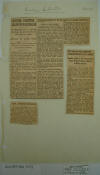
|
44.
June 19-26. Press
clippings: "Sandino
Fighting Again In Nicaragua"
(June 19), New York Times.
"Nicaraguan Bandits Concentrate
In Camps" (June 23), New
York Times. "Gen.
Sandino Wounded" (June 26),
Washington Star.
"SANDINO
FIGHTING AGAIN IN NICARAGUA ¶
His Representative in Mexico
City Says General Has Scored
Over Marines Twice. ¶ DETAILS OF
CLASH TOLD ¶ Captain Alfred
Johnson Leaves Here Tomorrow for
Nicaragua to Supervise Elections
There. ¶ MEXICO CITY,
June 18 (AP).—General Augustino
Sandino’s representative here
issued a statement today saying
the insurgent leader had
returned to Nicaragua and had
defeated United States Marines
in two encounters. ¶ The
representative Pedro José
Zepeda, declared Sandino’s men
had captured a Marine sergeant
and an aviator and in addition
had taken 10,000 rounds of
ammunition and many guns. ¶
Reports have been current all of
this year that General Sandino
was on his way back to
Nicaragua. ¶ The insurgent
chieftain gave the Marines much
trouble in Nicaragua in 1928 and
the early part of 1929, but
eventually sought asylum in
Mexico. ¶ Last July he took up
residence in Merida, Yucatan, in
the southern part of Mexico, and
there lived more or less
quietly. Rumors started in
January that he intended to
return to Nicaragua, and in
February he left Mexico with his
staff. Until now, however, his
whereabouts have been a matter
for speculation. ¶ After Sandino
had left Nicaragua the troubles
of the Marines and the
Nicaraguan National Guard were
not ended. They continued to
clash with small groups of
bandits and have had numerous
engagements in the last few
months. ¶ Details of
Clash Related. ¶
Special to The New York Times. ¶
WASHINGTON, June 18.—Details of
the fight on May 8 between
Nicaraguan bandits and a patrol
of the Nicaraguan National Guard
led by Second Lieutenant Edward
Lewis Livermore of Wellington,
Ohio, when four members of the
guard were killed and two
wounded, were received by the
Marine Corps today in a report
from Managua. ¶ “At 3 P. M., May
8,” the report said, “a National
Guard patrol led by Second
Lieutenant Edward Lewis
Livermore (a corporal in the
United States Marine Corps) was
surrounded and ambushed by a
group of bandits estimated to be
one hundred. The action occurred
as the patrol was making its way
down Barrial Hill. The bandits,
who were equipped with bombs,
three Thompson sub-machine guns,
one Lewis gun and rifles, opened
fire from four sides, the
advance guard being killed
immediately. ¶ “After two hours’
fighting the bandits were
dislodged from two hills in
front and in thirty minutes all
firing ceased. ¶ “Total
casualties of the National Guard
were four killed, two wounded.
All animals and supplies with
the patrol were lost.” ¶ To
Leave to Supervise Elections. ¶
Captain Alfred Johnson of the
United States Navy, who recently
was appointed by the Supreme
Court of Nicaragua as chairman
of the National Board of
Elections upon nomination by
President Hoover, will sail for
Nicaragua from New York on
Friday to prepare for the
supervision of the Congressional
elections in the Fall. He will
be the personal representative
of President Hoover in Nicaragua
with the rank of Minister and
will rank immediately after the
American Minister to Nicaragua.
¶ Officers who will assist him
in Nicaragua include Commander
A. S. Hickey, Major Henry L.
Larson, Lieutenant H. B. Edgar,
Major Charles F. B. Price, First
Lieutenant George L. Hollett,
Captain F. F. Fulton, Captain M.
B. Ridgway, Lieutenant R. P.
Erdman, Lieutenant D. Hyatt and
Lieutenant Paul B. Watson. ¶ The
enlisted personnel of the board
of elections is now practically
organized. Three hundred and ten
enlisted men in the Navy will go
from the submarine base at Coco
Solo, Canal Zone, and will
arrive at Managua on the west
coast of Nicaragua on July 10.
Fifty-four enlisted men of the
Marine Corps have been detailed
for assembly at Coco Solo, Canal
Zone, and will proceed to
Bluefields on the east coast of
Nicaragua, arriving July 10.
There is a possibility of Marine
Corps personnel augmenting the
west coast personnel. ¶ The
majority of the officers and men
of the national board
participated in supervising the
Presidential election in
Nicaragua in 1928. ¶
NICARAGUAN BANDITS CONCENTRATE
IN CAMPS ¶ Sandino Held to Be
Encouraging Move Which Follows
Advent of Rainy Season.
¶ Tropical Cable to THE NEW YORK
TIMES. ¶ MANAGUA, June 23.—The
situation in regard to the
bandits in the northern
provinces of Nicaragua has
changed since the beginning of
the rainy season. The National
Guard patrols notice that
instead of wandering in smaller
groups, the bandits seem to be
concentrating in larger camps. ¶
Similar moves have been made at
the beginning of previous rainy
seasons, but this year the camps
seem to be larger and the
concentration more intense. This
has lead [led] to a belief in
some quarters that the
concentration has stimulated and
urged by Augustino Sandino,
possibly with a view to a bandit
organization. ¶ The National
Guard, supported by Marines, is
equipped and prepared to meet
any development. ¶ American
Marine aviators, in a bombing
expedition last Thursday under
the command of Major Ralph
Johnson Mitchell of the United
States Marine Corps, displayed
their courage and ability in
attacking a bandit stronghold.
The bandits returned the
machine-gun fire of the planes,
shooting holes in the wings of
machines piloted by Captain
Johnson and Lieutenant J. .
Hart, but without effect on the
fire from the planes. The
bandits deserted their
stronghold after the attack,
going northward. ¶ GEN.
SANDINO WOUNDED ¶
MANAGUA, Nicaragua, June 25
(AP).—Gen. MacDougal, commander
of the Nicaragua National Guard,
yesterday said he had been
informed that Gen. Augustino
Sandino, insurgent leader, was
operating in the vicinity of the
mountains north of St. Rafael
and had been recently wounded in
the leg. ¶ The general’s
informant was a native
Nicaraguan captured by the
Sandinistas, who escaped
subsequently. He said he
recognized the famous insurgent
general."
|
|
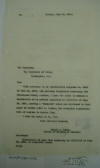
|
45.
June 20, 1930.
G-2 Translation of "Representative of the Defender
of Nicaragua Declares That the
Invaders Were Decimated —
Terrific Bombardments in the
South of Honduras — Violent
Fighting Taking Place Throughout
the Entire Sector of Matagalpa
and Rivas," El Excelsior,
Mexico City, June 13, Chargé d'Affaires
ad interim Edward P. Lowry,
Mexico City, to Sec. State,
Washington D.C., p. 1.
"No.
2564 ¶ Mexico, June 20, 1930. ¶
The Honorable ¶ The Secretary of
State, ¶ Washington, D.C. ¶ Sir:
¶ With reference to my
confidential despatch No. 2546
of June 13, 1930, and previous
despatches concerning the
Nicaraguan rebel, Sandino, I
have the honor to enclose a
translation of an article
appearing in EXCELSIOR of June
18, 1930, quoting a “bulletin”
which was delivered to that
paper by Doctor Pedro J. Cepeda
[Zepeda], the so-called
representative of Sandino in
Mexico City. ¶ I have the honor
to be, Sir, ¶ Your obedient
servant, ¶ Edward P. Lowry, ¶
Chargé d’Affaires ad interim. ¶
Enclosure: ¶ Translation of news
item appearing in EXCELSIOR of
June 18, 1930, as described
above. ¶ JGS/c . . . "
|
|
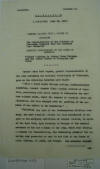
|
46.
June 20, 1930.
G-2 Translation of "Representative of the Defender
of Nicaragua Declares That the
Invaders Were Decimated —
Terrific Bombardments in the
South of Honduras — Violent
Fighting Taking Place Throughout
the Entire Sector of Matagalpa
and Rivas," El Excelsior,
Mexico City, June 13, Chargé d'Affaires
ad interim Edward P. Lowry,
Mexico City, to Sec. State,
Washington D.C., p. 2.
"
. . . Enclosure. ¶ Despatch No.
2564 ¶ T R A N S L A T I O N ¶
(EXCELSIOR: June 18, 1930) ¶
SANDINO CLASHES WITH A COLUMN OF
AMERICANS ¶ The Representative
of the Defender of Nicaragua
Declares that the Invaders Were
Decimated ¶ TERRIFIC
BOMBARDMENTS IN THE SOUTH OF
HONDURAS ¶ Violent Fighting is
Taking Place Throughout the
Entire Sector of Matagalpa and
Rivas ¶ Doctor Pedro José Cepeda
[Zepeda], general representative
of the Army defending the
national sovereignty of
Nicaragua, gave us the following
bulletin last night: ¶ “After a
rapid march through various
Centralamerican countries,
General Augusto César Sandino
arrived at Segovias, proceeding
with great energy to reorganize
the various columns which, under
the command of Generals Ortez
and Altamirano, had been charged
with the guarding of the arsenal
of war hidden in the mountains.”
¶ “Following the plan of the
Northamerican military command,
the most complete silence has
been maintained in regard to the
military activities of General
Sandino, in spite of the fact
that, upon learning in Managua
of the unusual movement of the
air columns of our Army, which
were obeying a command for
concentration, the bombarding
planes of the invading Army
proceeded at once to set fire to
the towns of Santa Bárbara, El
Limón, and Jalapa. The material
damages ¶ are . . . "
|
|
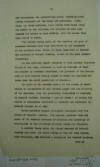
|
47. June 20,
1930. G-2 Translation of "Representative of
the Defender of Nicaragua
Declares That the Invaders Were
Decimated — Terrific
Bombardments in the South of
Honduras — Violent Fighting
Taking Place Throughout the
Entire Sector of Matagalpa and
Rivas," El Excelsior,
Mexico City, June 13, Chargé d'Affaires
ad interim Edward P. Lowry,
Mexico City, to Sec. State,
Washington D.C., p. 3.
"
. . . are tremendous, the
asphyxiating gases, thrown in
tons, having destroyed all the
crops and livestock. Seven women
and three children, whose bodies
were found among the debris by
our soldiers, are believed to
have been wounded and unable to
seek shelter, with the result
that they burned to death. ¶
“The entire region north of the
Segovias and part of southern
Honduras have been devastated by
the airplanes of the American
Navy, which, in their impotence
to destroy the soldiers of
General Sandino, resort to the
most inhuman procedures. ¶ “In
the official report received by
this general representation of
the Army, reference is made to
hundreds of dead and wounded in
Honduran territory, the protests
of the Government of that
country having failed to check
the repeated attacks upon the
civil population of Honduras. ¶
“In spite of the drastic orders
of the forces of occupation to
concentrate in the ‘prison
camps’ all the families of the
peasants, they are presenting
themselves in hundreds to
General Sandino, desirous – men
and women – of seeing the regime
of oppression initiated by
Chamorro and continued by
Moncada brought to an end. ¶
“Great optimism reigns
throughout Nicaragua over the
return of General Sandino. The
general receives from all parts
of the country messages of
adhesion and uprisings of
Nicaraguans in the so-called
National Guard are frequent. ¶
“A cavalry troop under the
direct command of General
Sandino presented the first
battle in the rio Tuma region,
near Matagalpa, and defeated a
column of two hundred marines, ¶
whom he . . . "
|
|
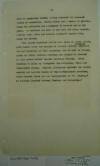
|
48. June 20,
1930. G-2 Translation of "Representative of
the Defender of Nicaragua
Declares That the Invaders Were
Decimated — Terrific
Bombardments in the South of
Honduras — Violent Fighting
Taking Place Throughout the
Entire Sector of Matagalpa and
Rivas," El Excelsior,
Mexico City, June 13, Chargé d'Affaires
ad interim Edward P. Lowry,
Mexico City, to Sec. State,
Washington D.C., p. 4.
"
. . . whom he completely routed,
having captured ten thousand
rounds of ammunition, thirty
rifles and a number of pistols.
Among the prisoners are a
sergeant of marines and an air
pilot. We suffered the loss of
six dead and seven wounded,
Captain López Irías and General
Sandino’s bugler being among the
latter. ¶ “The second important
battle took place at Cerro
Grande, with forces under the
command of General Estrada.
Complete details are not
available of this encounter, but
it will be famous, since the
first American airplane was
obliged to descend in this
second effort towards national
liberty. Brisk fighting is going
on throughout the Matagalpa,
Rivas and Prinzapolka region.
General Altamirano controls the
entire central and western
region of the lastmentioned
[last mentioned] province, while
General Ortez has his
headquarters in ‘La Sultana,’ an
hacienda located between
Jinotega and Matagalpa."
|
|
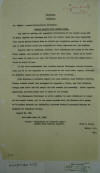
|
49. June 18, 1930. G-2 Report on Recent Reports from
Bandit Areas, Lt. Col. Fred T.
Cruse, Military Attaché, San
José.
"NICARAGUA
¶ POLITICAL ¶ No. 3020-d – Armed
Revolutionary Movements. ¶
Recent Reports from Bandit
Areas. ¶ The work of getting all
peaceable inhabitants of the
bandit areas out of Nueva
Segovia and Jinotega and into
the larger towns has been
completed. This leaves Marine
Planes free to attack any
suspicious persons in the areas
and to bomb houses which are
suspected of being hide-outs for
the bandits. ¶ Reports seem to
indicate, however, that
Altamirano has moved to the Coco
River region, and intends to
remain there for some time.
There is no doubt that early in
June he was near the Bonanza
Mine in the Pis Pis region with
a force of about 50 men. ¶ It
has been ascertained that
Sandino entered Nicaragua
through Totecasinte and he is
now supposed to be en route to
the Coco River region, although
no definite report of his
movements has yet been received.
¶ From Honduras a reliable
report has been received that
Porfirio Sanchez, former Sandino
chief, had attempted to organize
a force, and that Honduran
troops sent after him had caught
him and wounded him severely.
Later reports, apparently
accurate, state that he died of
his wounds. ¶ The Nicaraguan
Government is still anxious to
send volunteers to clean up the
bandit areas, and it now seems
certain that the Marines will
agree, as President Moncada has
definitely selected General
Francisco Parajon to command the
volunteer forces. ¶ Report No.
768 ¶ San José--June 18, 1930 ¶
Source – Evaluation of reliable
information from various
sources. ¶ Fred T. Cruse, ¶
Major, G.S. ¶ M.A."
|
|
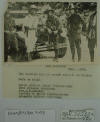
|
50.
June 1929. Photograph of
"Gen Sandino and his staff
enroute to Mexico" (in San
Salvador).
Caption:
"Left to right ¶
Ruben Ardilla Gomez (Venezuelan)
¶ Jose Paredes (Mexican)
¶ Gen. A. C. Sandino ¶
Agustin F. Marti (Salvadorean)
¶ Gregorio Gilbert (Haitian)"
|
United States National Archives, Record Group
165, Entry 77, Box 2653.
|
|
top of page |
|
|

